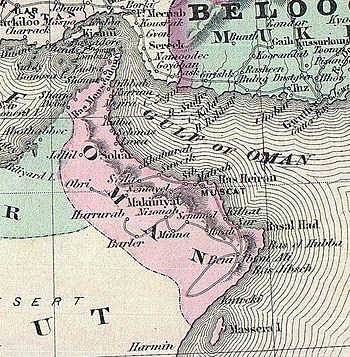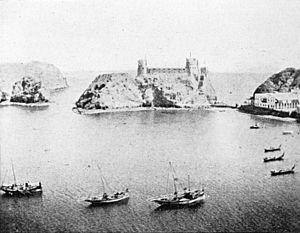Muscat and Oman facts for kids
Quick facts for kids
Sultanate of Muscat and Oman
سلطنة مسقط وعمان (Arabic)
|
|||||||||
|---|---|---|---|---|---|---|---|---|---|
| 1856–1970 | |||||||||
|
|
|||||||||
|
Anthem: None (until 23 July 1970)
From 23 July 1970: نشيد السلام السلطاني "as-Salām as-Sultānī" "Salute to the Sultan" |
|||||||||

The Sultanate of Muscat and Oman in 1867
|
|||||||||
| Status | De jure sovereign state (1856–1970) De facto British protectorate (1872–1920) |
||||||||
| Capital | Muscat | ||||||||
| Official languages | Arabic | ||||||||
| Common languages | Omani Arabic, Persian, Ottoman Turkish, English | ||||||||
| Religion | Islam (official) | ||||||||
| Government | Absolute monarchy | ||||||||
| Sultan | |||||||||
|
• 1855–1866 (first)
|
Thuwaini bin Said | ||||||||
|
• 1866–1868
|
Salim bin Thuwaini | ||||||||
|
• 1868–1871
|
Azzan bin Qais | ||||||||
| History | |||||||||
|
• Partition from Zanzibar
|
1856 | ||||||||
|
• Treaty of Seeb
|
25 September 1920 | ||||||||
|
• Jebel Akhdar War
|
1954 | ||||||||
| 1962 | |||||||||
|
• Deposition of Said bin Taimur
|
23 July 1970 | ||||||||
|
• Qaboos declares the Sultanate of Oman
|
9 August 1970 | ||||||||
| Currency | Omani dirham (1856–1892) Indian rupee (1892–1959) Gulf rupee (1959–1970) Saidi rial (1970–1972) Omani rial (1972–now) |
||||||||
|
|||||||||
| Today part of | Oman United Arab Emirates Pakistan Iran |
||||||||
The Sultanate of Muscat and Oman (Arabic: سلطنة مسقط وعمان, romanized: Salṭanat Masqaṭ wa-‘Umān) was a country that existed from 1856 to 1970. It included the area we know today as Oman, plus parts of the United Arab Emirates and Pakistan.
This country was ruled by the Busaid family. It was formed when the larger Omani Empire split apart after its last ruler, Said bin Sultan, passed away. The Sultanate changed its government in 1970. Sultan Said bin Taimur was replaced by his son, Qaboos bin Said, in a peaceful change of power.
Contents
What's in a Name?
The name "Muscat and Oman" shows two main parts of the region. Oman (also called the Imamate of Oman) was the inner, landlocked part. Its capital city was Nizwa.
Muscat was the coastal area, ruled by a Sultan. The rulers of Muscat were known for expanding their power, even across the seas. These two areas were separated by a mountain range called the Green Mountain.
Another part of historical Oman was the "Pirate Coast." This area later became known as Treaty Oman and is now the United Arab Emirates (UAE). The Dhofar Governorate is also a historical and current part of Oman.
A Look Back: Early History
The Portuguese colonizers were driven out of the region in the 17th century by the Yaruba Imams. These Imams then pushed the Portuguese out of East Africa. They built a strong sea empire that reached the Persian Gulf and Zanzibar.
Later, the Yaruba dynasty lost power to Persian colonizers. But in 1749, Imam Ahmad bin Said defeated the Persians. The British Empire wanted to control southeast Arabia. They aimed to limit the power of other European countries and weaken the Omani Empire.
So, the British supported the Albusaidi Sultans of Muscat, who came to power in the late 18th century. The British made many agreements with the Sultans. This helped Britain gain more political and economic power over Muscat. Over time, the Sultanate relied more and more on British money and advice.
There were always differences between the rich coastal Sultanate of Muscat and the tribes living inland. Even though the Sultans of Muscat officially controlled the inland areas, tribal leaders and the Imams of Oman actually ran them. These Imams followed a branch of Islam called Ibadi.

The Sultanate of Muscat had a very strong navy. This allowed them to create a large sea empire. This empire started after the Portuguese were expelled in 1650 and lasted through the 19th century. At different times, it included modern Oman, the United Arab Emirates, southern Balochistan, Zanzibar, and parts of Kenya, Tanzania, and Mozambique.
Growth and Challenges
In the early 1820s, the Sultanate lost most of its lands in the Persian Gulf. These areas became the Trucial States, which were protected by Britain. The fifth Sultan of the Al Said family, Said bin Sultan, made the Sultanate's lands and businesses stronger. Oman became very successful.
However, the Omani navy could not compete with the more advanced European navies. The Sultanate lost much of its trade with South Asia. The British also pushed them to stop the slave trade. This further reduced the Sultanate's political and economic power.
On June 4, 1856, Said bin Sultan died without naming who would rule next. The Al Said family members could not agree. Britain helped them decide. Two rulers were chosen from the Al Said family. Said's third son, Thuwaini bin Said, became the ruler of the mainland. His sixth son, Majid bin Said, became the ruler of an independent Sultanate of Zanzibar in October 1856. After this, the Sultans of Zanzibar had to pay money to Muscat every year.
The idea of an Imamate in Oman's interior became strong again. This was because the British were gaining more power in coastal Muscat. In 1913, Imam Salim Alkharusi led a rebellion against Muscat. He wanted to bring back an Imamate in the inland region. Both the Imamate and the Sultanate followed the Ibadi branch of Islam. However, their disagreement was mostly about politics. The people in the interior believed their ruler should be chosen by election. They did not like British control over the Sultanate. With British help, the Sultanate was able to defend itself.
This historical split continued for much of the 20th century. Sultan Taimur bin Feisal gave some self-rule to the Imamate of Oman under the Ibadi religious leaders. This was done through the Treaty of Seeb in 1920.
The last overseas land, the port of Gwadar across the Gulf of Oman, was sold to Pakistan in 1958. However, the Sultanate did gain some land in 1967. Britain returned the Khuriya Muriya Islands. These islands were originally given as a gift from the Sultan to Queen Victoria in 1854.
Conflicts and Oil
The discovery of oil in the Persian Gulf made the disagreement between the Sultan in Muscat and the Imams of Oman worse. Oil exploration had started in the early 1920s by the Anglo-Persian Oil Company. The Second World War stopped these activities for a while.
At that time, the Sultanate of Muscat faced very difficult social, economic, and political problems. The Sultanate was undeveloped, with no roads or telephones. Sultan Said bin Taimur banned anything he thought was "bad," like radios. The British government still had a lot of political control. The Sultan's main advisor, defense secretary, and almost all his ministers were British.
The British government, the Iraq Petroleum Company, and the Sultan wanted to find oil. They made plans in 1946 to create an army that could take control of the Imamate of Oman.
The last Imam of Oman, Ghalib Bin Ali, started a rebellion in 1954. This happened when the Sultan gave permission to the Iraq Petroleum Company to search for oil. The biggest oil fields were inside the Imamate's territory. The fighting stopped in 1955, but a longer conflict began. This became the Jebel Akhdar rebellion. Sultan Said bin Taimur relied heavily on British military help.
Iraq Petroleum, along with its oil exploration company, Petroleum Development Oman, was owned by large European oil companies. These included British Petroleum, which was the new name for Anglo-Iranian Oil. These companies encouraged the British government to support the Sultan.
The rebellion started again in 1957 when Saudi Arabia began helping the Omani rebels. But the Sultan was eventually able to gain control over most of the inland area. In the same year, British forces attacked the town of Nizwa, the capital of the Imamate. They ended the Ibadi religious government there. Ghalib Bin Ali went to live in Saudi Arabia. The last rebel forces were defeated two years later, in 1959. The Treaty of Seeb was ended, and the self-governing Imamate of Oman was no more.
The many rebellions, like the Dhofar Rebellion (supported by the communist government of South Yemen), made the British want to replace the Sultan. The British chose the Sultan's son, Qaboos bin Said. He had studied in the West but was kept confined in the palace by his father, who feared a takeover.
After his release, Qaboos bin Said, with the help of British military forces, successfully took power. He was declared Sultan of Muscat and Oman in 1970. The newly united areas, along with Muscat, were reorganized into the country we know today as the unified Sultanate of Oman by August 1970.
In 1976, again with British help, the Sultan secured his control over the entire inland area and stopped the Dhofar rebellion.
Sohar Sultanate
The Sohar Sultanate existed from 1920 to about 1932. In 1920, Sheik Ali Banu Bu Ali, who was related to Sultan Taimur bin Faisal, started a rebellion in the northern town of Sohar. He declared himself Sultan but was removed from power by the British in 1932.
See also
- History of Oman
- List of rulers of Oman
- List of British representatives in Muscat and Oman
- Muscat
- Imamate of Oman
- Provinces of Oman
- Gwadar




